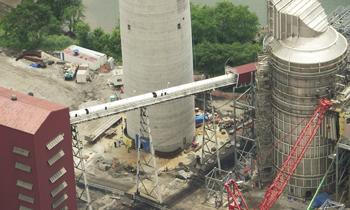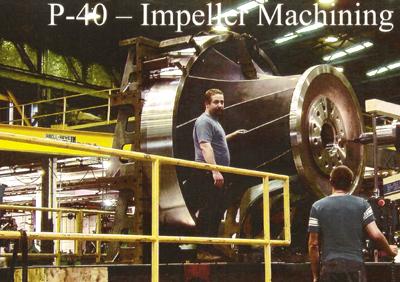AWS CWI, CWE, NDE Level III
- FMA
- The Fabricator
- FABTECH
- Canadian Metalworking
Categories
- Additive Manufacturing
- Aluminum Welding
- Arc Welding
- Assembly and Joining
- Automation and Robotics
- Bending and Forming
- Consumables
- Cutting and Weld Prep
- Electric Vehicles
- En Español
- Finishing
- Hydroforming
- Laser Cutting
- Laser Welding
- Machining
- Manufacturing Software
- Materials Handling
- Metals/Materials
- Oxyfuel Cutting
- Plasma Cutting
- Power Tools
- Punching and Other Holemaking
- Roll Forming
- Safety
- Sawing
- Shearing
- Shop Management
- Testing and Measuring
- Tube and Pipe Fabrication
- Tube and Pipe Production
- Waterjet Cutting
Industry Directory
Webcasts
Podcasts
FAB 40
Advertise
Subscribe
Account Login
Search
The many faces of stainless steel
- By Professor R. Carlisle "Carl" Smith
- March 5, 2012
- Article
- Metals/Materials
Stainless steel has been defined by some as steel containing 11 to 13 percent chromium. Others have declared the range to be 10.5 to 12 percent. Regardless of the opinions, the key element for distinguishing the nomenclature “stainless steel” is chromium.
To the uninformed, stainless steel is a shiny metal that is used for sinks and kitchen utensils. Nearly every household contains some Sheffield cutlery. The stainless parts on automobiles, such as the hubcaps, usually are referred to as chrome. The most commonly produced and used stainless steel is the 300 series. The steels in this category are shiny or a dull gray. The exact surface condition is determined by the end user. A 2B finish is dominant for most industrial uses other (heavier thicknesses) than sheet products.
The 300 series is austenitic. One common 400 series is martensitic. My English-teaching colleagues have scolded me for teaching with poor grammar. I teach my students to remember that the austenitic group begins with an A and therefore it ain’t magnetic. The martensitic group begins with an M and it is magnetic.
The other common 400 group is ferritic. The terms ferrite and iron are related, so we say AIM. A for austenitic, I for ferritic. and M for “martensitic”. Austenitic, martensitic, and ferritic do not refer to atomic elements; rather they are phases reflected at various temperatures and magnetic conditions. The magnetic permeability (how much or how little they are susceptible to magnetization) is determined by a Severn gage, also called lo-mu detection.
Relatively new types of stainless steels are duplex (2205, 255, etc.) and superduplex. Slightly magnetic, they are used frequently in the electric power industry for scrubbers (Figure 1) and in other corrosive atmospheres. Although these alloys have been in use for about three decades, extensive research and experimentation with them are ongoing. The welding materials used for duplex steel usually are determined by the corrosion resistance requirements. In many cases, these alloys are overwelded with high-nickel alloys that produce enhanced corrosion resistance properties.
The 300 Series
The three-digit numbering system (e.g., 304) for stainless steel was established by the American Iron and Steel Institute (AISI) in the early 1930s. These numbers still are reflected in the Society of Automotive Engineers (SAE) and the Unified Numbering System (UNS) designations (for example, SAE 30304 and UNS S30400).
In the earlier days, 304 was referred to as “18-8,” which reflects its 18 percent chromium and 8 percent nickel composition. This alloy was developed by the famous Krupp Laboratories in Germany in the early 1900s. The other 300 series materials also were named by the amount of chromium and nickel they contained; for example, 310 was called “25-20.”
In 1935 Allegheny Ludlum Steel worked with Ford Motor Company to build a 1936 Ford sedan (Figure 2) from a modified 304 alloy. It was beautiful, but the cost was prohibitive.
There are nearly 30 different types of 300 series alloys, including five within the 304 group. Additions of various elements make the material suitable for different applications. The 304L has extra-low carbon. This once was referred to as “304ELC.” Reduced carbon helps minimize the probability of carbide precipitating into the heat-affected zone (HAZ).
Adding nitrogen—304N—increases the surface hardness of the material.
Adding hydrogen—304H—enhances heat and pitting resistance. This material type is used in the heat shields for high-temperature areas of boilers. Tube shield producers and users often specify 304H. Its carbon content ranges from 0.04 percent to 0.10 percent.
A similar alloy is the 316 group. The 316H has more nickel content than 304, which makes it tougher and stronger at higher temperatures.
Because it contains 0.25 percent carbon, 24 percent to 26 percent chromium, and 19 percent to 22 percent nitrogen, plain 310 material probably is best among the 300 series for elevated temperatures.
An interesting number exists in the 300 series that is not really classified as a stainless alloy by the UNS. It is the 330 alloy, and its dominant element is nickel rather than chromium. This alloy is an excellent choice for corrosion resistance, even in some highly acidic conditions. Rather than an S prefix, UNS uses an N, which designates it as a high-nickel alloy.
The 300 series materials are readily fabricated by welding, rolling, punching, shearing, and plasma or waterjet cutting. However, problems can occur if the welding procedure is not properly specified: a phenomenon called sensitization takes place. Subjecting the alloys to a temperature of about 800 degrees to 1,500 degrees F, even for a short length of time—say, 8 to 10 minutes—will cause sensitization. Carbides can precipitate into the grain boundaries because of chromium depletion. Intergranular corrosion can occur and may cause cracking when stresses are applied. Also, the welding procedure should specify much lower amperages and interpass temperatures than those required for carbon steel. This tends to keep the material out of the sensitizing zone.
Most common welding processes may be used with proper procedures. The oxyacetylene process is not recommended, but may be used if magnetism or electrical current must be avoided. The Linde Air Company once made a flux for this process. Its parent company, Union Carbide Corp., used this process in one of its plants to prevent electrical current from flowing into a chemical producing area. They used very large welding tips that allowed faster travel speeds to minimize the amount of time spent at the higher temperatures.
Although uncommon, some companies use thermal heat treatment on the 300 series materials, which discolors the alloy but serves to demagnetize and relieve stress on large weldments that need several weld passes. It also is used for solution annealing on materials that have been exposed to sensitization. This process requires heating the material to 2,200 to 2,500 degrees F and quenching. It is not useful for local heat treatment; the entire weldment must be treated.
The 400 Series (Straight Chromium)
The 400 series ferritic materials contain from 11 to 30 percent chromium and very small amounts of carbon. The lower carbon content increases ductility but also decreases the strength.
These alloys are referred to as straight chromium because they differ from the 300 alloys, which are referred to as nickel-chromium. The 400 series does not contain nickel as a major alloying element. These materials resist stress corrosion cracking much better than the 300 series alloys do. Because they resist pitting and flaking and are considered to be fairly tough, they often are used for pump impellers (Figure 3) and volutes. The 430 alloy is somewhat wear-resistant and may even produce some martensite.
The 400 series martensitic materials are somewhat similar to the ferritic, but have a smaller amount of chromium (11 to 18 percent). The 440 alloys have from 16 to 18 percent chromium. They also possess considerably higher carbon content, along with 0.75 percent molybdenum, which further enhances their ability to resist heat-related problems.
Because of the ready formation of martensite, this material can be harder than the ferritic group. Sometimes this material is used along with some chromium molybdenum parts to form burning nozzles for furnaces and boilers. The martensite provides the hardness required in those applications in which wearing is a problem.
The Duplex Series
The term duplex is derived from the concept of a material that is produced as both austenitic and ferritic in composition. This was an unheard of phenomenon in past times. At least a dozen different types of material are now available in this series. Arguably, the 2205 and 255 types are the most commonly used today. Their chemical compositions are similar, except that the chromium, nitrogen, and molybdenum content of the 255 is slightly higher, and the carbon is only 0.01 percent higher. The nitrogen enhances the surface for both corrosion and wear resistance.
These alloys were introduced in the U.S. in the early 1990s at the American Electric Power headquarters in Columbus, Ohio. A group from the Netherlands, the U.K, and an engineer/researcher from the Lincoln Electric Company presented a general seminar about the material. I was among the group of attendees from nearly all areas of industry that would be interested in this somewhat new material—fabricators, welding supply companies, engineers, metallurgists, and educators interested in getting in on the ground floor of a new generation of useful alloys.
Duplex alloys offer a cost advantage, especially when compared to the higher-nickel alloys. In comparison to the 300 series, the greatest cost advantage is the ability to use lighter and thinner material, because of the duplex’s increased yield strength—nearly double that of the 300 series.
Welding duplex material is relatively easy compared to welding other corrosion-resistant nickel and chromium-nickel alloys. A higher heat input is acceptable for duplex, and this material does not require stringer beads. A slight weave is not only allowed, it is recommended by most welding experts. The ferrite content enhances the material’s weldability.
Several welding wires have been developed specifically for joining these alloys, such as ER 2209, E2209-T1, and E2209. Depending on the severity of the corrosive atmosphere, the material lends itself well to overwelding with high-nickel/molybdenum welding materials.
A favorite for overwelding in scrubber fabrication is ERNiCrMo-3. This wire offers the weld and HAZ better protection from intergranular contamination by chromium carbides. As with the other nickel and chromium-nickel alloys, cleanliness remains a factor, no matter the material.
The machining rate for duplex alloys is in the same range as for the 316 austenitic alloys. Duplex machines much better than high-nickel alloys. Forming the duplex material is similar to forming 50 KSI carbon steel.
About the Author

Professor R. Carlisle "Carl" Smith
Weld Inspection & Consulting
PO Box 841
St. Albans, WV 25177
304-549-5606
subscribe now

The Fabricator is North America's leading magazine for the metal forming and fabricating industry. The magazine delivers the news, technical articles, and case histories that enable fabricators to do their jobs more efficiently. The Fabricator has served the industry since 1970.
start your free subscription- Stay connected from anywhere

Easily access valuable industry resources now with full access to the digital edition of The Fabricator.

Easily access valuable industry resources now with full access to the digital edition of The Welder.

Easily access valuable industry resources now with full access to the digital edition of The Tube and Pipe Journal.
- Podcasting
- Podcast:
- The Fabricator Podcast
- Published:
- 04/30/2024
- Running Time:
- 53:00
Seth Feldman of Iowa-based Wertzbaugher Services joins The Fabricator Podcast to offer his take as a Gen Zer...
- Industry Events
Pipe and Tube Conference
- May 21 - 22, 2024
- Omaha, NE
World-Class Roll Forming Workshop
- June 5 - 6, 2024
- Louisville, KY
Advanced Laser Application Workshop
- June 25 - 27, 2024
- Novi, MI
Precision Press Brake Certificate Course
- July 31 - August 1, 2024
- Elgin,


































